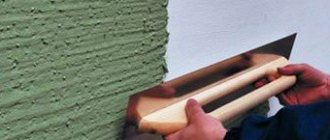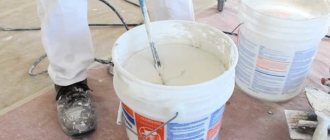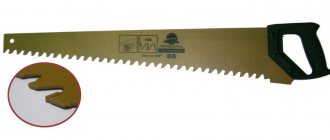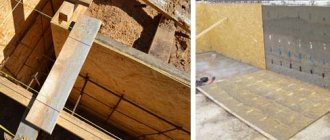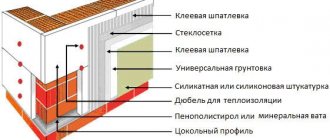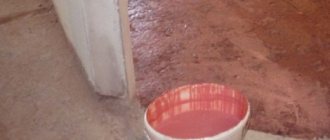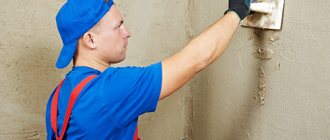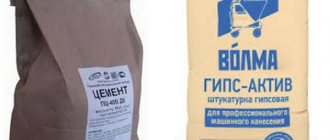What is bark beetle plaster
The bizarre patterns that the grinder beetle leaves on a cut of wood served as the basis for the creation of plaster with the unusual name Bark Beetle. It is a Western development, and appeared in domestic construction at the end of the 20th century. This is a unique finishing coating for interiors and facades. The secret of the decor lies in the presence of small pebbles in the solution. This type of plaster is no less popular than Danish, Venetian, “Lamb” and “Shuba”.
Compound
The first component is the astringent component, which is the base. It can be cement with the addition of polymers or polymer resins such as latex, silicone and acrylic. The specific type of binder base determines the characteristics of the plaster. The second component is the grain, which provides the appearance of the grooved texture. Its main parameter is the fraction size. The larger the grains, the deeper the grooves will be. This plaster composition is also characterized by increased consumption. In general, the grain fraction is always indicated on the packaging.
Kinds
Most manufacturers offer a variety of bark beetle species. There are such plasters for facades or interior work. The category of universal compositions is highlighted separately. There is a classification according to the level of preparation for application - semi-finished plaster in the form of a suspension, already painted and packaged in buckets, and a dry mixture with granules, packed in a bag. The latter is much more difficult to tint. Plasters are also classified according to their binder:
- Mineral. The basis is cement and lime. They are cheap, but very practical. They are easy to apply, you can even use your hands.
- Silicate. This is liquid glass with high compressive strength, durability and vapor permeability. The only drawback is the high price.
- Acrylic. They contain acrylic resins. Such mixtures have good characteristics both for façade cladding and for interior walls. The downside is poor resistance to sunlight.
Application technology
An important condition for obtaining a beautiful coating is the correct technology for applying the bark beetle. It can be used on different surfaces - drywall, brickwork, concrete and particle boards. Before applying plaster to the wall, it is cleaned of the remnants of the previous finish, then the cracks are filled with putty, and after drying, with a primer, if this is an interior.
Next, the dry component of the mixture is gradually poured into a clean container with water added in the required dosage specified in the instructions and mixed until smooth. Then the mass is left for 10-15 minutes under the lid. The technique of how to plaster with bark beetle includes the following steps:
- Using a grater or spatula, holding them at an angle of 60 degrees, apply the mixture to the wall.
- Then, using circular movements or up-down or side-to-side movements, spread the mass into an even layer, remove the excess and immediately distribute it to a new area.
- Mix the solution thoroughly every five minutes.
- Puff pastry dough - recipes with photos. How to make yeast puff pastry at home
- How to grow the endometrium
- Folk remedies for hair loss and hair growth
Applying plaster
Finishing work, as a rule, begins with the preparation of the material itself. Ready-made plaster simplifies the task: make sure that the expiration dates are in order. They usually do not harden quickly, so there is no need to rush when applying.
The packaging of the dry mixture should contain detailed instructions for its preparation. Compositions diluted with water on their own harden quite quickly - you will have to calculate the portions to avoid drying out directly in the working container.
First, the solution is applied in an even layer to the wall using a spatula. Then, when the coating begins to harden, the desired relief is created.
After drying for 15-20 minutes, using a damp trowel you need to carefully smooth out the resulting relief. After about a day, the dried surface is treated with fine sandpaper.
Read more: TOP best HP printers
Facade finishing
The façade is often finished with bark beetle. This is due to the good resistance of the material to atmospheric influences. In addition, in terms of price relative to the regions of Moscow and St. Petersburg, plaster belongs to the category of affordable materials. It also has the advantage of a wide range of colors, so you can easily choose the one you need for your home. Facade plaster most often consists of cement and marble chips, but there are other types.
Decorative plaster Exterwell, Osnovit
Price:
- 25 kg – 828 rubles.
Characteristics:
- adhesion strength to the base – 0.65 MPa;
- vapor permeability coefficient – 0.1 mg/mchPa;
- frost resistance – 50 cycles;
- operating temperature – from -50 to +65 degrees;
- shelf life – 12 months.
Pros:
- variety of patterns - city, classic bark beetle, rain;
- ease of application;
- weather resistance.
Minuses:
- No.
Weber-Vetonit min Bark beetle
Price:
- 25 kg – 559 rub.
Description:
- frost resistance – 100 cycles;
- consumption – 2.6-2.8 kg/m2;
- grain size – 2 mm;
- adhesion strength – 0.35 MPa;
- binder – lime, cement;
- color – gray;
- shelf life – 12 months.
Pros:
- non-flammable;
- vapor permeable;
- for painting.
No cons
What types of textured plaster are there?
Before you begin creating the interior or exterior decoration of a room, you need to decide on the most suitable finishing material.
We list the main types of textured plaster:
- Acrylic. From the name itself it is clear that it is based on acrylic resin. It is offered on the market in plastic containers of various sizes. It is already ready to use, so you will save time on diluting it. It is better to use the entire mixture at once, however, if necessary, you can store it in a closed container.
- Silicone. The main component of this plaster is a polymer resin, which creates the necessary level of protection for walls from sudden changes in temperature and moisture. It can be used indoors and outdoors, as well as as a decor for stoves.
- Silicate. The binding element is liquid glass. This mixture is characterized by impeccable vapor permeability, as it is actively used for finishing concrete. It is characterized by increased resistance to mechanical stress, maintaining its original attractive appearance for many years.
- Mineral. For its production, components such as concrete and lime are used. They can be supplemented with sand, quartz or some other minerals. It is made in powder form and requires additional dilution with water until a homogeneous mass is obtained.
Today, the market offers a variety of types of decorative plaster, and they all have their own characteristics.
Among such a wide range there are both dry and liquid textured mixtures. It can be roller, volumetric or structural, since the texture composition of all types is developed individually. VGT plaster is in high demand, as it is highly effective and economical in consumption. Packing
The manufacturer offers all textured mixtures in the form of a ready-made solution or powder. The standard is 25 kg packaging, but there are other weight categories. Dry options are relatively inexpensive and can be stored much longer in a closed container. The process of preparing a solution of the required consistency will not be difficult if you strictly follow the instructions. At the same time, transporting these mixtures is much more difficult, resulting in the possibility of inconvenience and damage to the packaging.
Textured plaster in the form of ready-made solutions is a more convenient option. It is packaged in plastic containers, which are equipped with handles for more convenient transportation. The most common weight containers with the finished mixture are 16 and 25 kg. In this form, the products are resistant to moisture, and their shelf life is 12 months.
Colors
For a beautiful and proper design of the space, it is important to carefully choose the colors used when decorating the room. It is worth saying that textured plaster is offered on the market in a rich variety of colors, including both colored and white mixtures. When choosing, we advise you to take into account the fact that the same finishing color may look different on different textures.
Texture options for decorative plaster:
- Brilliant. Has the smoothest possible surface. Color clarity is clearly visible in only one direction. From a different angle on the ceiling or wall, the color will look a little distorted.
- Matte. Creates a finely porous and rough surface on which the color of the texture is equally beautifully reflected (and from all sides).
- Glossy. It is distinguished by the presence of blocks, which can influence the perception of the color scheme of the finish.
Experienced designers advise taking into account when choosing that the color on a textured surface will always be much darker than on a smooth texture.
In order for a surface with a textured finish to be durable and of high quality and have a presentable appearance, you need to use a full set of tools and proven compositions during work.
To work you will need:
- putties of different sizes;
- textured mixture;
- trowel;
- brushes, rollers and paint;
- plumb and level;
- grater;
- masking tape;
- additional devices necessary to create texture.
All of the listed tools and mixtures will allow you to create a beautiful and high-quality surface, taking into account all your needs and wishes.
Design and style
Textured plaster has quite many faces. Depending on your idea, you can use it to create an excellent background, give a particular area a special flavor, or support the overall style of the interior. The versatility of this finishing material makes it popular when decorating a space.
Textured texture allows you to create:
- beautiful reliefs, drawings and patterns;
- imitation of natural stone;
- an ideal basis for further wall painting;
- the structure of wood, fabric, concrete, paper or leather;
- unusual wall panels.
Types of facade plaster according to structure:
- "bark beetle";
- "lamb";
- plaster paint;
- "fur coat".
The diversity of this material contributes to its use in various stylistic directions. To decorate the outside of a room, textured plaster with a fur coat or bark beetle effect is usually used. It is relatively rough in appearance, so it is rarely used indoors.
The decor of the ceiling or walls with imitation of Turkish leather, stone, fabric and natural wood looks unusual. Pearl plaster, as well as decorative sea waves and flowers created with its help, add romance and sophistication to the room.
Textured plaster is often used in loft style. It is used as a basis for painting in Scandinavian and American style. In addition, this finishing material perfectly complements other design areas, making the interior more original and stylish.
Application options and methods
For different types of premises, certain methods of finishing with textured plaster are provided. Each option can transform the appearance of the interior, making it unique and unique.
There are two ways to create decor using this material:
- Creating patterns using special tools. This option is simple and not so expensive, which is why it is in great demand.
- Applying the ornament using a textured roller. This technique allows you to create a neat and clear pattern with a uniform texture.
In addition, ready-made stamps are often used to create a pattern on a particular surface. By applying them to a pre-plastered wall, you will get a beautiful ornament or design. After completing the process of applying the texture, it needs to create conditions for normal drying, which usually lasts at least a day. Only then can you begin to remove excess plaster, primer and paint.
Do not forget that when creating such decor you do not need to penetrate deep into the base of the wall. Otherwise, after the plaster has completely dried, your decorative elements may simply fall off.
In rooms exposed to frequent mechanical stress, textured plaster must be coated with colorless varnish or wax. Thus, you will preserve the original qualities of the material, its aesthetics and practicality.
In the kitchen
To make the kitchen not just comfortable, but also functional, you need to carefully consider the finishing of the ceiling and walls. Thanks to its excellent soundproofing and waterproofing qualities, as well as environmental components and the absence of seams, textured plaster has become an excellent solution for finishing such premises. When decorating a kitchen using this material, you should consider the recommendations of experienced designers:
- Choose the right color palette. It is important that it matches harmoniously with the flooring, furniture and other accessories.
- Plaster should only be used on one wall. An excellent option for focusing attention on one of the walls or zoning the space.
- Use for ceiling finishing. A light and neat ceiling will give the kitchen lightness and freshness.
For small kitchens, we recommend using fine-grained textured plaster, while in larger kitchens it is better to use a mixture with a large relief. A protective layer of wax or varnish will help ensure the practicality and durability of this finish.
In the children's room
Due to its many positive features, this plaster is an excellent material for decorating children's rooms. Using such a universal material, you can create almost any surface that will perform not just an aesthetic, but also a practical function. Using special stencils, you can apply a variety of designs to the ceiling or walls. In children's rooms, design designs in the form of clouds, sea waves, cartoon characters, geometric patterns and other interesting images are in high demand.
We recommend giving preference to an option with a high level of wear resistance. If you are planning to change the interior, then repaint the ceiling and walls to get a new design. Sometimes textured plaster is used as a protective layer that is applied to children's furniture. This method allows you to preserve its original properties for many years.
In the office and bedroom
Since textured plaster is resistant to delamination and fading, it is actively used to decorate walls in offices and bedrooms. Its color, texture and thickness may vary, depending on preferences and wishes. Using special tools and this mixture, you will create a unique design in the room and be able to hide unevenness or any other imperfections.
When starting to decorate the interior of the bedroom, you need to take into account such an indicator as the volume of space. In small rooms it is better to use light shades, while in larger rooms dark shades in the form of certain accents will be more appropriate. In spacious bedrooms, a combination of several types and shades of textured plaster is allowed, which will harmoniously combine with each other, maintaining a cozy atmosphere.
If your bedroom is located in the north, it is better to use coffee, beige, orange and pink tones. It is recommended to decorate rooms with high-quality natural light in blue, green, red and gray colors.
When decorating your home office, we recommend sticking to a restrained and strict style. The design of the ceiling and walls should be combined with furniture and other interior items. A cabinet decorated with concrete, antique, velvet and brick looks beautiful and stylish. Each option is attractive in its own way and creates a working atmosphere.
In the corridor
The design of a hallway or corridor requires a special approach. It is the corridor that creates the first impression of the owners and the house as a whole. It is also impossible not to take into account the fact that the walls here are subject to constant loads, which can cause chips, abrasions and the appearance of dirt. Therefore, when choosing textured plaster, give preference to the most practical and durable options.
With this finish, you can create an original corridor design with a relief surface that imitates stone, natural wood and other materials. This finish is quite easy to care for, which allows you to maintain its original appearance for many years. In addition, a neat and stylish corridor will make a good impression on your guests and can become the calling card of the entire house.
For interior work
Less stringent requirements apply to bark beetles for interior work. The main condition is the ability of the surface to be decorated to adhere. The plaster will not adhere to smooth metal or glass materials. The advantage of this type of decoration for interior walls is the ability to create a wide variety of patterns. Thanks to this, you can decorate the interior in any design option.
Bark beetle decor UNIS
Price:
- 25 kg – 370 rub.
Description:
- vapor permeability – 0.1 mg/mchPa;
- drying time – 2-3 days;
- consumption at a thickness of 2 mm – 3.5-4.5 kg/m2;
- grain size – no more than 2 mm;
- White color;
- shelf life – 12 months.
Advantages:
- “breathable” coating;
- does not scratch;
- can be painted multiple times.
Flaw:
- No.
Knauf Diamant Bark beetle grain 1.5 mm
Cost:
- 25 kg – 370 rub.
Description:
- vapor permeability coefficient – 0.1 mg/mchPa;
- consumption – 2.5 kg/m2;
- grain size – 1.5 mm;
- color scheme – white;
- operating temperature – from -50 to +65 degrees;
- shelf life – 12 months.
Advantages:
- variety of design;
- protection and increased strength;
- Possibility of machine application.
Flaw:
- high consumption.
Specifications
It is worthwhile to dwell in more detail on the following indicators, which are presented in the table:
| Consumption | 8-9 kg per 1 sq.m |
| The most acceptable layer thickness | 5-30 mm |
| Maximum layer thickness | 6 cm |
| Drying time | 5-8 days |
| Water consumption | 600-650 ml per 1 kg |
| Base temperature | +5-+30 |
| Starts to set | In 45-50 minutes |
| Finishes setting | no later than 3-3.5 hours |
| Compressive strength | not less than 3.5 MPa |
| Flexural strength | not less than 1.5 MPa |
As you can see from the table, the working time with the mixture is truly optimal - 45 minutes. But it is best to consume the mixture within 25-30 minutes.
Important! When purchasing dry material, buy a little more than you actually need. This is necessary so that during the work you can dilute more mixtures at any time and finish what you started.
Founds
The main function of the Osnovit finish is to create not just a decorative, but also a protective layer. Most often used in systems with rigid insulation fastening. This finish is recommended for use in cultural and leisure centers, lobbies, hallways, administrative premises and common areas. The base can be cement and cement-lime plasters and putties, foam and aerated concrete.
Exterwell OS-1.0 WK, Osnovit, white (color-matched)
Price:
- 25 kg – 488 rub.
Characteristics:
- vapor permeability – 0.1 mg/mchPa;
- adhesion strength – 0.65 MPa;
- consumption – 1.6-1.8 kg/m2;
- grain size – 1.0 mm;
- frost resistance – 50 cycles;
- operating temperature – from -50 to +65;
- shelf life – 12 months.
Pros:
- variety of design;
- ease of application;
- Possibility of painting in any color.
Minuses:
- No.
Exterwell OM-2.5 WK, Osnovit, super white
Cost:
- 25 kg – 889 rub.
Characteristics:
- vapor permeability coefficient – 0.1 mg/mchPa;
- adhesion – 0.65 MPa;
- consumption – 1.6-1.8 kg/m2;
- grain size – 2.5 mm;
- frost resistance – 50 cycles;
- operating temperature – from -50 to +65;
- shelf life – 12 months.
Advantages:
- variety of design;
- ease of application.
Flaw:
- the large fraction is more suitable for outdoor work.
Knauf
Knauf is one of the leaders in the finishing materials market. More often it is presented in the form of a dry mixture that needs to be prepared. To do this, it is diluted in certain proportions with water. Its quantity is indicated in the instructions on the package. The fraction size ranges from 1.5 to 2.5 mm, so the product can be used both inside and outside.
KNAUF DIAMOND BARK BEETLE GRAIN 2.5 MM
Price:
- 25 kg – 370 rub.
Characteristics:
- vapor permeability coefficient – 0.1 mg/mchPa;
- type – cement;
- consumption – 3.5 kg/m2;
- grain size – 2.5 mm;
- frost resistance – 50 cycles;
- Shelf life – 12 months.
Pros:
- resistance to shock and vibration;
- possibility of application by machine;
- high quality.
Minuses:
- high consumption.
KNAUF DIAMOND GRAIN 1.5 MM
Price:
- 25 kg – 370 rub.
Description:
- vapor permeability coefficient – 0.1 mg/mchPa;
- type – cement;
- consumption – 2.5 kg/m2;
- grain size – 1.5 mm;
- frost resistance – 50 cycles;
- Shelf life – 12 months.
Pros:
- resistance to shock and vibration;
- possibility of application by machine;
- special plasticity;
- high quality.
Minuses:
- No.
Comparison by price
Conventionally, all manufacturers represented on the Russian market can be divided into three price segments - lower, middle and upper:
- Upper price segment (paints with an average price per square meter from 1000 rubles) - European brands Baldini (Be careful - this brand is counterfeited in Belarus), Sammarinese, Loggia, Giorgio Graesan, Sammarinese, Oikos, Valpaint, NovaColor. Russian brands are not represented here.
- Average price segment (paints with an average price per square meter from 400 rubles) - European brands Ferrara Design, San Marco, Veneziano; Russian manufacturers (Don’t be fooled by the foreign name!) – Decorazza, Clavel, Pratta, Natura Interior, Paritet Décor, Art Deco, Derufa, Adicolor, Decorici.
- Lower price segment (paints with an average price per square meter of up to 400 rubles) - Russian brands VGT, Bayramix, Descartes, Elitas, Ceresit.
We will not advise you which segment to choose, since there are options for every budget.
Ceresit
Among polymer compositions, Ceresite bark beetle enjoys especially good reviews. But due to the improved quality of finishing, it has a higher cost. In addition to ready-made options, Ceresit products are also presented in the form of dry mixtures. They belong to the mineral category. Diversity also lies in a wide range of textures, so you can choose a large or fine finish.
Ceresit CT 60, CT 63, CT 64
Price:
- 25 kg – 2300-2400 rub.
Description:
- type – mineral;
- consumption – 2.5-4.0 kg/m2;
- grain size – 1.5-3.0 mm;
- frost resistance – 100 cycles;
- service life – at least 10 years.
Pros:
- already ready for use;
- strength and durability.
Minuses:
- No.
Ceresit CT 35 “Bark beetle”
Cost:
- 25 kg – 2300-2400 rub.
Characteristics:
- type – mineral;
- consumption – 3.0-4.0 kg/m2;
- grain size – 2.5-3.5 mm;
- frost resistance – 75 cycles;
- service life – at least 10 years.
Advantages:
- environmentally friendly;
- hydrophobic;
- shockproof.
Flaw:
- high consumption.
- Knitting socks on 2 knitting needles for beginners
- Vapor tube for newborns: how to use, video
- Treatment regimen for nail fungus with Fluconazole, reviews
Gypsum plaster
This type of plaster mixture is used for plastering the surfaces of ceilings and walls inside various domestic, office or residential premises. When thinking about which plaster is better for plastering dry heated rooms with large uneven walls, you should give preference to gypsum plaster. This will be the best solution. Plastering in thick layers up to 10 cm is allowed, due to the absence of shrinkage, which eliminates the appearance of cracks and peeling. To obtain a perfectly flat surface, which will not require puttying in the future, it is also best to use this type of plaster mixture. This is due to high adhesive properties and excellent ductility. In addition, gypsum plaster has fairly good sound and heat insulation properties. One of the main advantages of this type of mixture is that they are “breathable” and do not interfere with room ventilation. This property is especially important when decorating the walls of residential premises. At the same time, this material also has a rather serious drawback - it has low moisture resistance. This means that the use of gypsum plaster in rooms with high humidity is not possible. It should only be used for interior decoration of dry heated rooms. It should also be noted that gypsum plaster is not “friendly” with concrete. She doesn't hold on to it at all.
Bergauf
Products from Bergauf can also be used for interior and exterior work. It is a white dry mixture based on a cement binder. Other components are chemical additives, marble chips and mineral filler. The consumption of the mixture is high - for 1 square meter you will need about 2.5-3 kg. Another advantage is that you can paint the finished finish or tint the material in bulk.
BERGAUF DECOR (Bergauf)
Price:
- 25 kg – 545 rub.
Characteristics:
- binder - cement;
- strength – M100;
- consumption – 2.5-3.0 kg/m2;
- grain size – 2.5 mm;
- operating temperature – from -50 to +70;
- frost resistance – 50 cycles.
Pros:
- environmentally friendly;
- Possibility to paint several times.
Minuses:
- high consumption.
Bergauf DEKOR WINTER
Cost:
- 25 kg – 468 rub.
Characteristics:
- binder - cement;
- strength – M100;
- consumption – 2.5-3.0 kg/m2;
- grain size – 2.5-3 mm;
- operating temperature – from -50 to +70;
- frost resistance – 75 cycles.
Pros:
- suitable for thermal insulation of facades;
- Application is possible at low temperatures.
Minuses:
- No.
Decorative plaster: varieties
Decorative plaster, including facade plaster, is not just a good substance for decoration, which gives the facade of a house or interior a special look. Plaster is also a protective layer from various types of natural disasters: excessive sun, moisture, frost, as well as mechanical damage. Like other finishing materials, decorative plaster is divided into types and types according to different parameters: appearance, properties and substances included in its composition. And in order to be more knowledgeable in the whole variety of categories of decorative plaster, let’s consider its advantages and disadvantages. Let's start with the composition:
- It is a dry powder mixture that must be diluted with water and stirred regularly to prevent lumps from forming. Despite its low cost, this plaster is very durable and can withstand prolonged exposure to wind and sun. For example, mineral plaster is almost ideal for a bathroom, since it allows water vapor to pass through. Among the disadvantages, we note its inelasticity, so over the years it can crack and be subject to mechanical stress.
- It is highly resistant to stains and has high strength. Silicone plaster is easy to use. It combines well with a variety of bases, is elastic and resistant to natural and mechanical damage. Among its many competitors, it is distinguished by its richness of color - about 7000 color shades, however, its cost is quite high.
- Silicate decorative plaster
It has a good range of colors and is used to decorate the facade of a building.
Its advantages
are low price, resistance to natural and mechanical stress.
The disadvantages
include difficulty in working, since it is almost impossible for a non-professional to plaster the facade of a building with it. - A wide range of shades, elasticity and inexpensive price significantly distinguish it from other coatings. Minus
– does not allow water vapor to pass through well, and as a result, drops of water appear in the insulating layer. This is where mold and dampness appear. Acrylic decorative plaster is not recommended for use as the final finishing layer.
Here everything depends largely on its composition. So, if the composition contains a transparent stone no more than 4 mm in diameter, then such plaster will be grainy. If its base is marble or sand, then multi-colored pebbles-dyes are added to it right at the factory, which give it a certain shade (there are about 40 of them). Conventionally, based on its texture, the plaster is called “lamb” and “bark beetle”. The only difference is that the “bark beetle” is given relief with a special roller or textured spatula. Here you can achieve various relief effects: cyclic stripes, circles and even two-color painting. “Lamb” usually comes in a standard shape.
Today there are many brands, types and types of decorative plasters on sale, but among them there are also favorites.
Baumit
Baumit finishes are sold ready for use. It is a paste-like silicone mixture that can be immediately applied to the wall. Used in a thermal insulation system for facades in combination with expanded polystyrene, cork or mineral wool. It has many advantages - from abrasion resistance to self-cleaning effect.
Silicone plaster BAUMIT SILIKONTOP 2 R SN 10, BARK BEARD
Price:
- 30 kg – 485 rub.
Characteristics:
- vapor permeability – 0.020 mg/mchPa;
- consumption – 2.5-4.2 kg/m2;
- grain size – 1.5-3 mm;
- frost resistance – 75 cycles.
Pros:
- low pollution;
- easy to apply;
- washable.
Minuses:
- No.
BAUMIT SILIKATTOP 2 R SN 10
Price:
- 25 kg – 485 rub.
Description:
- vapor permeability – 0.020 mg/mchPa;
- consumption – 1.8 kg/m2;
- drying time – 24 hours;
- grain size – 2 mm.
Advantages:
- ready for use;
- for manual or machine use;
- low pollution.
Flaws:
- No.
VGT
Another type of rollerball, i.e. relief finishing is presented by VGT. Refers to acrylic compositions, which are much more difficult to apply, but they look very beautiful. Another advantage is that there is no need to dilute it, because the mixture is already ready for application. It is produced for sale in white color, so the composition is first tinted.
VGT Roller decorative plaster with bark beetle effect
Price:
- 18 kg – 1490 rub.
Characteristics:
- consumption – 0.3-0.5 kg/m2;
- drying time – 48 hours;
- dilution with water – up to 5%;
- grain size – 1.5-2.5 mm.
Advantages:
- enough to cover a large area.
Flaws:
- No.
VGT Roller decorative plaster with bark beetle effect
Price:
- 9 kg – 790 rub.
Description:
- vapor permeability – 0.020 mg/mchPa;
- consumption – 0.3-0.5 kg/m2;
- drying time – 48 hours;
- dilution with water – up to 5%;
- grain size – 1.5-2.5 mm.
Pros:
- enough to cover a large area.
Minuses:
- No.
Safety comparison of decorative paints
For a long time we could not determine this indicator accurately so that we could make some kind of comparison. All manufacturers have a SGR - a certificate of state registration, some have a declaration of conformity - this is when the manufacturer himself promises that his material is safe (which you can’t do to get your product bought...). But after looking at other markets, we found the right solution in suspended ceilings and wallpaper - this is the presence of the European Safety Mark. This sign shows the amount of harmful volatile organic substances released into the indoor air.
- The purest materials have an A+ index, and among manufacturers of decorative plaster, only the brands Sammarinese, Ferrara Design and Baldini were able to show us this mark.
- The safety of other manufacturers (not only ours, but also European ones) has not been confirmed by specialized tests, or they could not provide us with such information.
In this comparison, we do not recommend using materials that do not have a safety certificate in children's rooms, in rooms where allergy sufferers or people susceptible to allergies live. Yes, however, in any room where you spend a long time. If you decide to apply such materials, then this is only permissible when applied to the facade of a house. Take care of yourself!
Bayramix
A mixture from Bayramix is applied in a thicker layer. It is recommended for use when decorating facade insulation systems made using the “wet” type. Suitable for application to almost any surface. This can be concrete blocks, cement plaster, gypsum and plasterboard, all types of wooden surfaces. More often, such finishing is used in public buildings.
Bayramix Baytera (Bayramix Baytera) - Thick-layer plaster with mineral filler
Cost:
- 20 kg – 1890 rub.
Description:
- consumption – 2.5-4.0 kg/m2;
- drying time – 24 hours;
- grain size – 1.5-2.5 mm.
Pros:
- 16 colors;
- hides minor defects;
- High strength.
Minuses:
- No.
Bayramix Baytera
Price:
- 20 kg – 1890 rub.
Characteristics:
- consumption – 2.5-4.0 kg/m2;
- drying time – 24 hours;
- grain size – 0.25 cm.
Advantages:
- 16 colors;
- hides minor defects;
- High strength.
Flaws:
- No.
Bayramix Baytera
Price:
- 25 kg – 2570 rub.
Description:
- consumption – 2.0-3.0 kg/m2;
- drying time – 24 hours;
- grain size – 0.15 cm.
Pros:
- 16 colors;
- hides minor defects;
- High strength.
Minuses:
- No.
FAQ
We selected 7 questions about gypsum plaster and tried to answer them in as much detail as possible. Didn't find your question among those listed below? Feel free to ask it in the comments to the article!
What is the most important thing when choosing a mixture? What should you pay attention to first?
If it is not you, but professionals, who will be working, then indicate the required quality of the finished surface. For example, under wallpaper without the need for putty. Experts themselves will tell you which material is better. This is usually the one they are used to working with.
It’s more difficult if you decide to do the repairs yourself. First of all, pay attention to the condition of the packaging and the date of manufacture. If the shelf life is only six months, and the mixture was made 5 months ago, it is better to refuse the purchase.
Beginners need to choose mixtures that ensure the viability of the solution within 40-60 minutes, so that there is time to correct all the flaws.
Different solutions stretch and grout differently - this can only be checked in practice or by watching a video with reviews of the product. If the amount of work ahead is large, and the choice is limited to 3-5 items, purchase a bag of each mixture and try them out. This will help you save money in the future.
What is the difference between gypsum and cement plaster?
Gypsum and cement are the main components in gypsum and cement plasters, respectively. Therefore, the main characteristics of the prepared solution and the base leveled with it depend on them. To visually compare the plasters, we compared them according to several criteria.
| Comparison criterion | Plaster | |
| plaster | cement-sand | |
| Price/consumption | As paradoxical as it may sound, the cost per square meter of finishing with both types of plaster is approximately the same. This happened because gypsum is less dense, hence its comparatively low consumption. To the same extent, gypsum mixtures are more expensive. Hence the finishing costs are approximately the same | |
| Convenience | As a rule, the pot life of gypsum solutions ranges from 20 to 90 minutes. During this time, it can be used without risk to the finishing technology. For this reason, such a solution is prepared in small portions - in order to meet the deadline | The viability of cement-sand mortars is usually higher - from 2 hours. This allows you to work more calmly and mix more solution at a time |
| Both options can be used for the mechanized application method we discussed here | ||
| Durability | Depends on the indoor microclimate | High, time-tested |
| Vapor permeability | Around 0.1÷0.14 mg/m×h×Pa | Around 0.1 mg/m×h×Pa |
| The vapor permeability of the layer is determined by the ratio of the components included in the mixture. In general, the difference in this indicator is not so significant that its value can be taken as a significant advantage of gypsum plaster | ||
| Thermal conductivity | 0.23 W/m×°С | 0.6÷0.9 W/m×°С |
| Lower thermal conductivity provides some degree of wall insulation (the contribution is insignificant due to the small thickness of the layer). At the same time, it is very tactile: a wall plastered with cement-sand mortar is colder than one finished with plaster | ||
| Scope of application | Only in rooms with low and normal air humidity, for interior decoration in the bedroom, nursery, hallway, living room. The exception is special moisture-resistant compounds. | In any conditions, for exterior and interior decoration |
| Weak spots | The leveling layer can be deformed under mechanical stress, because it is relatively soft. Under certain conditions, the coating accumulates moisture, which affects the development of mold on the walls. Finishing with gypsum composition is carried out in heated rooms | The mass of the finishing layer is greater, which is reflected in an increase in the load on the walls, the total value of which can be very significant. It is important to accurately maintain the ratio of the components of the solution - the result of the work depends on this. Less flexible, more difficult to apply and stretch. |
Are there ready-made plasters in the form of a solution?
We hope that when comparing materials you have long stopped thinking in terms of “good and bad”. Universal solutions have not yet been invented, so gypsum compositions work better in some conditions, and cement-sand compositions in others.
To level the bases, the use of such solutions is not advisable. But you can find ready-made decorative mixtures on sale, but that’s a completely different story.
What do you recommend for leveling walls in the bathroom and kitchen?
Bathroom, kitchen, toilet - all these are wet rooms. We do not recommend using gypsum-based mixtures for them. In this case, cement-sand compositions are better suited.
However, you can go your own way: look for the words “moisture-resistant plaster”, etc. on the packaging. They are designed specifically for wet areas. For example, “Eunice Teplon moisture resistant”, “Prospectors Mixter”, etc.
What plaster should I use for plasterboard walls and ceilings?
Mixtures that do not require subsequent puttying are suitable. For example, “Volma Layer”, “Volma Layer Ultra” and other analogues. We especially draw your attention to the fact that some manufacturers emphasize that their products are not designed for this type of use. This is the case for Bergauf et al.
We bought the mixture. What else is needed?
Minimum set of tools: a container for mixing the solution, a mixer, a trowel, a trowel, and usually a wide spatula. Materials include dry mixture, clean water, and in some cases, reinforcement mesh and perforated corners. When working with surfaces of questionable quality, care should be taken to purchase a primer composition (it is selected based on the material and condition of the walls).
Tell us about plastering technology. Is it worth leveling the walls and ceiling yourself or is it better to turn to professionals?
There may be several approaches to carrying out basic work, but the truly “correct” one is indicated on the packaging with your dry mixture. We offer you the following sequence:
- To achieve maximum connection between the solution and the wall material, it is necessary to clean their surface from dust, dirt, falling off material, and greasy stains. The most convenient way to get rid of dust and small adhering debris is with a wide brush. Excess masonry mortar is beaten off with a hammer. It is advisable to further strengthen the surface layer with a deep penetration primer. Their choice is determined by the nature of the surface: moisture-absorbing and non-moisture-absorbing substrates - as well as the required speed of work (depending on drying time);
- After mixing the solution, the beacons are placed, fixing them point by point using plaster. The beacons are leveled in such a way that subsequently the thickness of the finishing layer is as small as possible. First, their position is determined, markings are made, then several cakes are thrown in a vertical plane in increments of 30-50 cm, into which they are leveled into the solution according to the markings. You also need to understand that the shorter the distance between the beacons, the more convenient it is to work. The maximum distance between them is limited by the length of the rule. This stage is universal in nature, so it is discussed in more detail here;
- Using a trowel or trowel, the mortar is thrown onto the wall in such a way that the dimensions of the cakes subsequently ensure the thickness of the plaster layer of the required size. They immediately fill the entire plane, limited by two beacons, the floor and the ceiling;
- Using an h-shaped rule, distribute the solution over the entire area limited by the beacons. Excess solution is removed or applied to areas with “bald spots”;
- After the solution has set, they pass over the surface with a rule-cutter. It is important to maintain the correct time from leveling the layer to trimming. Usually you can start working half an hour after leveling, but it is better to make sure that the plaster is ready for this operation. This is determined by trial trimming: if the tool does not trim the top layer, but also pulls the rest of the mass, then the time has not come yet - only excess material should be cut off. But there is one more nuance here, because the layer can be overexposed;
- approximately 2 hours after applying the mixture to the wall, they begin to putty the surface. To do this, moisten the resulting surface using a spray bottle. After it stops shining, which will indicate the absorption of liquid, the wall is rubbed with a float. The process is accompanied by the transition of the plaster components into the liquid phase - milk is formed, which is rubbed in a circular motion over the treated area;
- at the next stage, additional smoothing of the finished area is carried out using trowels or wide spatulas. If it is necessary to obtain a glossy surface of the walls, then on the second day it is moistened with water and passed with a spatula until the desired result is achieved;
- after a time set by the manufacturer, depending on the thickness of the layer, the wall is ready for subsequent finishing work (painting or wallpapering)
Read more: Price list for car wash services
— prepare the floor for work by covering the part adjacent to the wall with sheets of tin, cardboard or thick polyethylene. This will allow the fallen solution to be reused;
— you need to work quickly with gypsum mortar. If you are a beginner, then mix a volume of solution that is enough to level the area between two beacons;
— how exactly to apply the solution: from bottom to top or from top to bottom? It doesn't matter, the main thing is that you are comfortable. It can be thrown on or spread on;
- don’t even think about getting the desired surface in one pass. Moreover, you should not try to make it smooth in some small area - work on the entire selected area at once;
— when decorating the walls of a private house made of blocks or bricks, it is recommended to use mesh for reinforcement. This is especially true for new buildings where shrinkage is possible;
— it is better to remove the beacons. The resulting groove can be easily repaired later, but in this case we will get a monolithic coating without metal inserts that can rust
Is it possible to lay tiles on gypsum plaster?
Can. And many manufacturers directly indicate this in the instructions, for example, the same Knauf. The plastered surface must be primed for dust removal and better adhesion to the tile adhesive. Also consider the load from the tiles and the thickness of the plaster layer. The higher they are, the more reasons there are to refuse gluing tiles to a plaster surface. This is especially true for wet rooms that can be flooded by neighbors above.
Dufa
For places with increased operational load, Dufa products are recommended. The list of premises includes offices, halls, corridors, staircases. The walls in them can be made of any materials - plywood, gypsum boards, chipboard, concrete, fiberboard. As a result, the surface becomes more resistant to moisture, steam and mechanical stress.
Dufa REIBEPUTZ 15 D 11 m textured
Price:
- 15 kg – 743 rub.
Characteristics:
- consumption – 0.4 kg/m2;
- tinting - Dufa MIX;
- grain size – 0.12-0.18 cm.
Advantages:
- suitable for thermal insulation;
- shockproof;
- crack-resistant.
Disadvantages:
- No.
Dufa Reibeputz 25 “Bark beetle” 2.5mm
Cost:
- 25 kg – 2100 rub.
Description:
- consumption – 0.4 kg/m2;
- tinting - Dufa MIX;
- grain size – 0.22-0.28 cm.
Pros:
- easy to apply;
- reliable;
- Suitable for facades and interiors.
Minuses:
- No.
De Luxe
Among acrylic mixtures, products from the De Luxe company have proven themselves well. It is intended for several types of work at once - finishing facades and interiors, installing thermal insulation systems. Available in two types. The first is a white mixture with the possibility of subsequent tinting, and the second is ready-made plaster, tinted by the manufacturer in accordance with RAL.
ACRYLIC De Luxe
Price:
- 25 kg – 2100 rub.
Characteristics:
- consumption – 1.9-3.6 kg/m2;
- base color - white;
- operating temperature – from -50 to +50;
- adhesion strength – 0.5 MPa;
- grain size – 0.15-0.3 cm.
Pros:
- easy to apply;
- good vapor permeability;
- wear resistance.
Minuses:
- No.
How to choose
To choose the right bark beetle plaster, you will have to take into account a number of factors. The main ones are the following:
- Release form - dry mixture or ready-made. In the latter case, the composition includes synthetic silicone or acrylic fillers, which impart plasticity. This does not characterize the dry mixture. In addition, it still needs to be prepared first.
- Type of composition. Acrylics look somewhat more attractive, but are also more difficult to apply. In addition, they are more expensive. It is much easier to work with a dry gypsum-cement composition, but it takes longer, because it needs to be prepared.
- Grain size. The consumption of the mixture will depend on this. Coarse-grained types are suitable for finishing facades, and fine-grained ones are suitable for interiors.
- Manufacturer and cost. Bark beetle coating is produced by many companies, but it is better to purchase from trusted and well-known ones. It is important to choose only from the category available to you at a price. In addition, you can keep track of promotions, discounts and sales. You can order the material in the online store with delivery by mail. Another option is to buy directly from a hardware store.
Tips from the professionals
If you know which gypsum plaster is best for you, then you should use some recommendations:
- Before each new mixing of the solution, the residues from the container must be removed and rinsed thoroughly. Frozen particles will have a detrimental effect on the quality of mixing the mixture.
- Prepare the solution according to the instructions given on each package.
- Choose the right tools to work with the plaster mixture. You should have two spatulas prepared: a short one and a long one.
- If you are going to plaster the walls with such a mixture, then make sure that they are not painted with oil paint. If it is not possible to clean the surface from it, then it is necessary to apply notches along the entire wall. They will serve as an ideal adhesion between the plaster and the surface.
- If you want to achieve a perfectly smooth wall, then after applying the plaster, spray it with water from a spray bottle. After this procedure, carefully polish the surface with a long metal spatula, preferably stainless steel.
